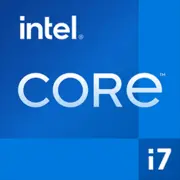Intel Core i7-12700H

Intel Core i7-12700H: Power and Efficiency for Modern Laptops
In 2025, Intel's 12th generation Core processors remain relevant due to their balanced performance and energy efficiency. One of the key representatives of this lineup is the Intel Core i7-12700H, which has gained popularity among laptop users. Let's explore what sets it apart, who it is suitable for, and what to consider when choosing a device based on it.
Architecture and Process Technology: Hybrid Cores and 24 MB Cache
The i7-12700H processor is built on the Alder Lake architecture using the Intel 7 process technology (10 nm Enhanced SuperFin). This is Intel's first hybrid design for laptop solutions, combining two types of cores:
- 6 Performance-cores (P-cores) with Hyper-Threading support (12 threads) for resource-intensive tasks.
- 8 Efficient-cores (E-cores) without Hyper-Threading for background processes.
The total number of cores is 14, with 20 threads. The frequencies vary:
- Base frequency of P-cores: 2.3 GHz, E-cores: 1.7 GHz.
- Maximum turbo frequency of P-cores: 4.7 GHz.
Cache: 24 MB of L3 cache enhances responsiveness in multithreaded scenarios (rendering, video encoding).
Integrated Graphics:
- Intel Iris Xe (96 EU).
- Support for 4K/60 FPS, AV1 decoding, HDMI 2.1.
- Performance comparable to entry-level discrete GPUs (e.g., NVIDIA MX450), allowing for light gaming (CS:GO, Dota 2) on medium settings.
Power Consumption and TDP: Balancing Power and Autonomy
The nominal TDP of the processor is 45 W, but in turbo mode, power can reach 95–115 W depending on the laptop's cooling system.
- In ultrabooks, manufacturers often limit TDP to 35–45 W to reduce heat output.
- In gaming laptops with active cooling, the processor reveals its full potential.
Power-saving Technologies:
- Intel Dynamic Tuning 2.0 — automatically adjusts power based on workload.
- Thread Director — allocates tasks between P-cores and E-cores for optimized power consumption.
Performance: From Office Tasks to AAA Games
According to Geekbench 6 tests (2025):
- Single-Core: 2202 — higher than the Ryzen 9 6900HX (2050) and Apple M1 Pro (2100).
- Multi-Core: 11406 — lags behind the Ryzen 9 7940HS (13000+), but surpasses the previous generation Intel (i7-11800H — 9500).
Real Scenarios:
- Office Tasks (Chrome, Excel): 8–12% load, instant response.
- Multimedia: Rendering 4K video in Premiere Pro is 30% faster than the i7-11800H.
- Gaming: Paired with NVIDIA RTX 3060/4070 — stable 60+ FPS in Cyberpunk 2077 (High, DLSS).
Turbo Boost Mode:
Under transient loads (app launches, rendering), the frequency of P-cores rises to 4.7 GHz, but extended loads (over 5–10 minutes) may result in throttling due to overheating.
Use Cases: Who is the i7-12700H Designed For?
1. Professionals:
- Video editors, 3D designers, programmers. DDR5 and PCIe 4.0 support speeds up work with large data sets.
2. Gamers:
- Full HD/2K gaming with a discrete graphics card.
3. General Users:
- Streaming, graphics work, multitasking.
Battery Life: How Long Will the Battery Last?
In laptops with a 70–90 Wh battery:
- Office Mode (brightness 150 nits, Wi-Fi): 6–8 hours.
- Video Playback: 4–5 hours.
- Heavy Load (gaming, rendering): 1.5–2 hours.
Energy Savings:
- Switching to E-cores in sleep mode reduces power consumption to 2–5 W.
- The Adaptix Battery Boost feature in some ASUS and Lenovo models extends battery life by 10–15%.
Comparison with Competitors
1. AMD Ryzen 9 6900HX (Zen 3+):
- Better multithreaded performance, but weaker in single-core tests.
- TDP of 45 W, integrated Radeon 680M is more powerful than Iris Xe.
2. Apple M1 Pro:
- More energy-efficient (up to 12 hours of work), but limited compatibility with Windows software.
3. Intel Core i9-12900H:
- 10–15% faster, but more expensive and hotter.
Pros and Cons
Strengths:
- High single-core performance.
- Support for DDR5 and Thunderbolt 4.
- Versatility for work and gaming.
Weaknesses:
- Heating under load requires effective cooling.
- In budget laptops, it may not reach its full potential due to TDP limitations.
Recommendations for Choosing a Laptop
1. Types of Devices:
- Gaming (MSI Katana GF76, $1400–$1600): Powerful cooling, RTX 4060/4070.
- Ultrabooks (Dell XPS 15, $1700–$2000): Slim body, 4K OLED display.
- Workstations (Lenovo ThinkPad P1, $2200+): Support for ECC memory, ISV certification.
2. What to Look For:
- Cooling System: Minimum of 2 fans + heat pipes.
- Battery: At least 80 Wh for better battery life.
- Display: For gaming — 144 Hz, for work — 100% sRGB.
Final Conclusion
The Intel Core i7-12700H is an optimal choice for those seeking a balance between performance, price, and battery life. It is suitable for:
- Gamers who do not want to overpay for an i9.
- Professionals working with "heavy" applications.
- General users who value speed in everyday tasks.
In 2025, laptops with this processor can be found in the price range of $1200–$2000, making them a favorable alternative to the new 14th generation Intel and Ryzen 8000 models. The main thing is to choose devices with a quality cooling system and a high-capacity battery.
Basic
CPU Specifications
Memory Specifications
GPU Specifications
Miscellaneous
Benchmarks
Compared to Other CPU
Related CPU Comparisons
Share in social media
Or Link To Us
<a href="https://cputronic.com/en/cpu/intel-core-i7-12700h" target="_blank">Intel Core i7-12700H</a>



